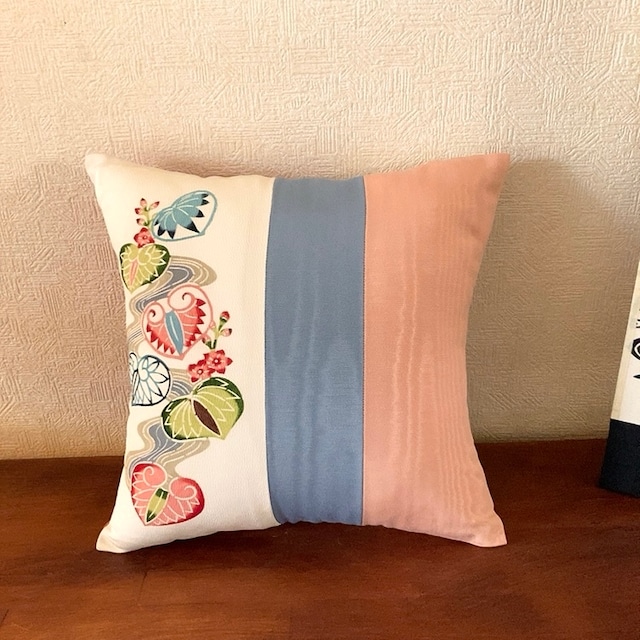5,000円以上のご購入で
送料無料
【モダン紅型】流水に菊、松、紅葉 (クッションカバー)


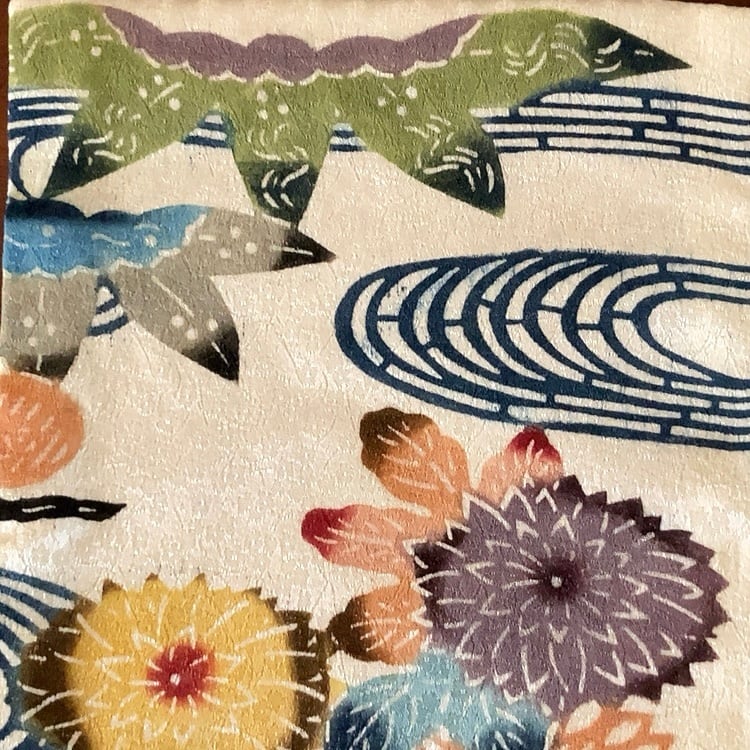






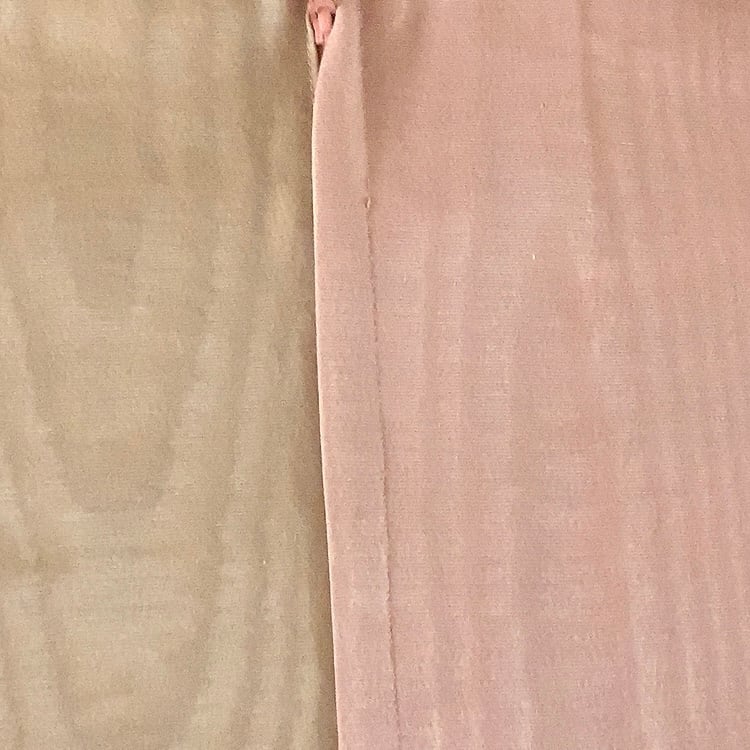
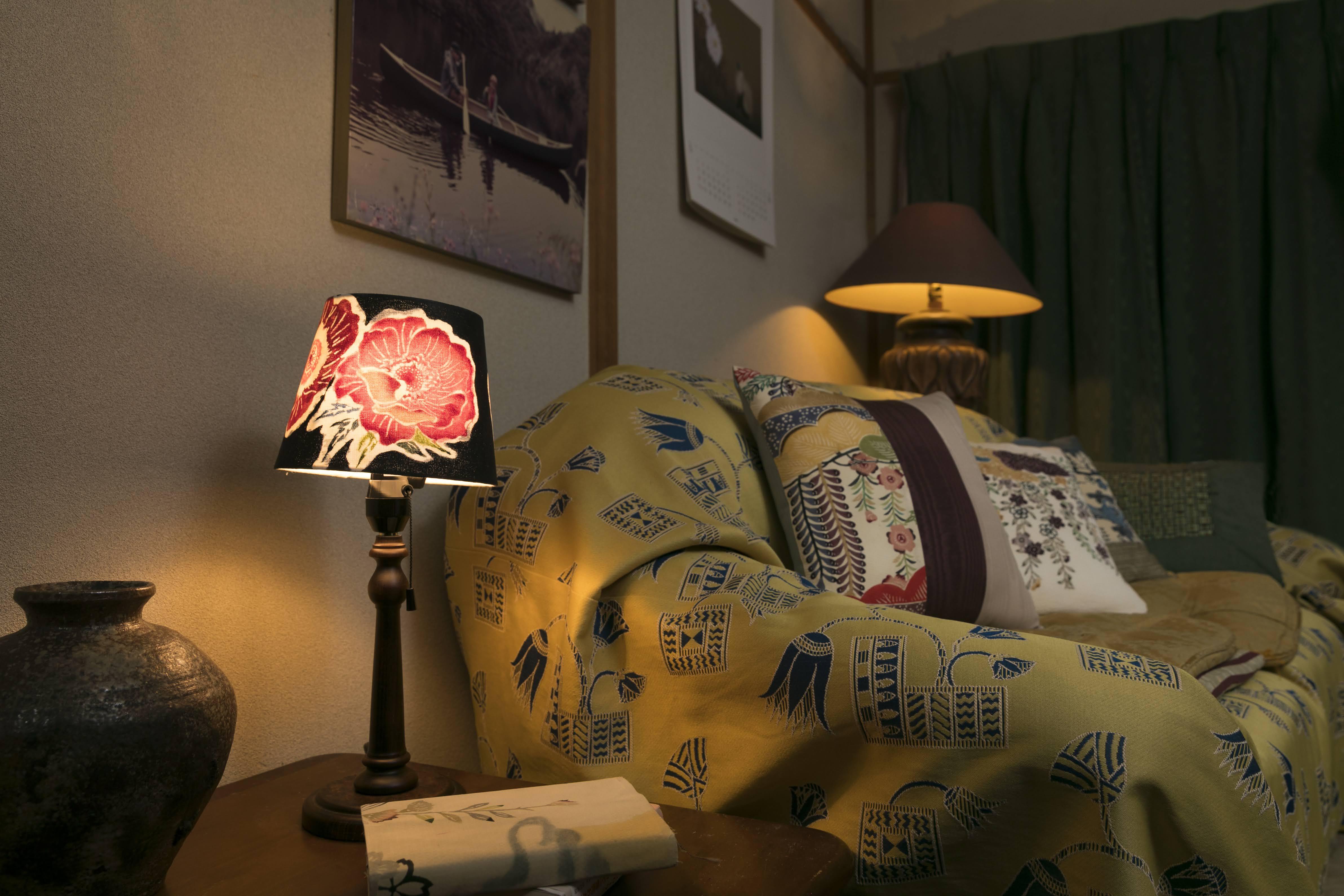

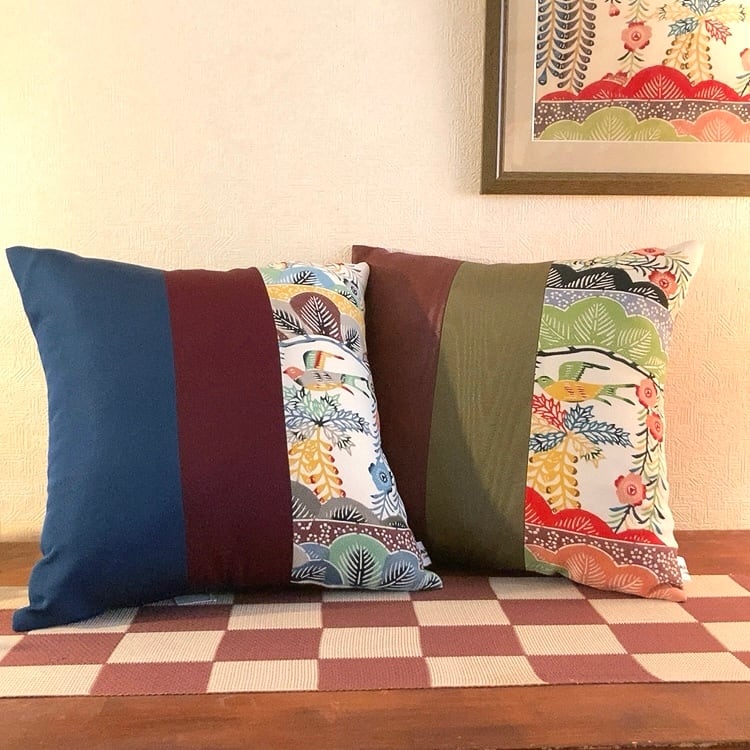
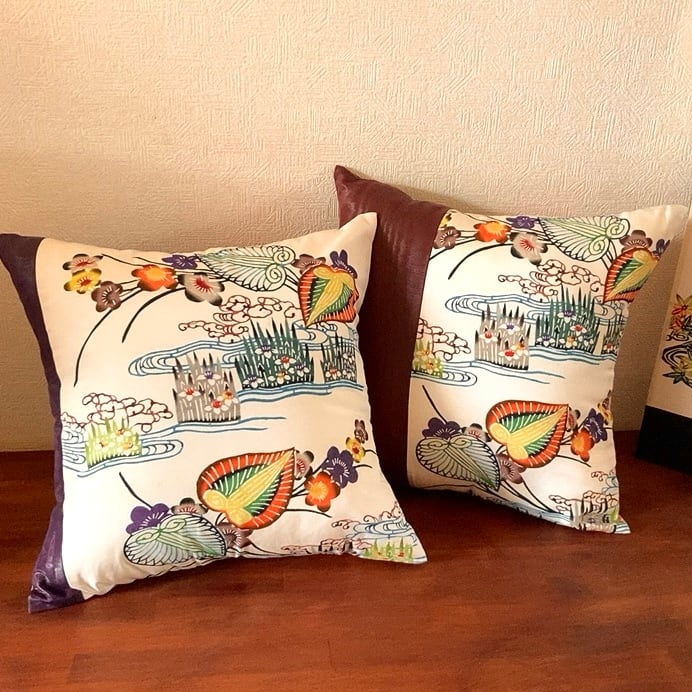



5,000円以上のご購入で
送料無料
【モダン紅型】流水に菊、松、紅葉 (クッションカバー)
【モダン紅型】流水に菊、松、紅葉 (クッションカバー)
¥14,300
流水に菊、松、紅葉のクッションです。(クッション材なし)
柔らかな雰囲気がお部屋を明るくしてくれる可愛らしいアイテムです。
インテリアのアクセントに使うのもおすすめです。
ソファやベッド周りなどに置くだけでお部屋が華やぎます。
日常生活に染めの彩りを添えてみませんか?
<流水文>
弥生時代に流行した文様のひとつ。平行線の端部を屈折させてS字状に連ねた平行曲線文様。
水が川に流れているさまや池になどにたまっているさまを図案化しています。
水をモチーフにした文様は古くから見られ、流水文の出現はその中でも最も古いと言われています。流水文の特徴は植物や動物と組み合わせたものが多くみられます。
<菊文>
菊は昔から秋を代表する植物です。絵画や工芸品にも多く取り入れられています。
菊文としての意匠化も鎌倉から室町時代に見られ、桃山時代には日本的意匠化の秋草の一つとして扱われるようになりました。江戸時代には鉢作りを競うほどに品種改良が進んで菊の種類も多くなり、それを映して菊の意匠も可憐な野菊から大輪のものまで、様々な表現が現れ、まさに菊文が咲きほこった時代となりました。
<松文>
松の幹・枝・葉または松かさを図案化した文様です。竹・梅と並んで吉祥文様のひとつ。
日本では神の依(よ)る木として門松などにされ、古くから長寿や慶賀を表すものとして尊ばれています。
<紅葉文>
楓の葉などを図案化した文様です。春の桜と並んで、秋の紅葉は古くから文様として用いられ、唐草や波、流水など他の文様とも取り合わされてきました。
色づき落葉した楓の葉を「紅葉」と呼びます。「かえで」はこの形がカエルの手に似ているのでこの名があります。
--------------------------------------------------------
サイズ:高さ:約39cm×横:約39cm
染色生地:絹(地紋柄:小花柄)
※購入前に必ずご確認下さい※
◆おかめ工房オリジナル商品です。
◆手染めになりますので、一点ものです。
◆染めムラなどある場合がございます。ご了承ください。
※商品の色は、可能な限り実物に近い色を出そうとしておりますが、携帯やパソコン、スマホのモニター環境により若干異なって見える場合がございます。
--------------------------------------------------------
<紅型染め工程>
1.型彫り:デザインを決め、型紙へ転写し、模様部分から彫っていきます。
2.紗張り:型紙を紗という生地で補強、固定する作業です。カシュー液またはペンキを使用します。
3.糊置き:型紙の上からペースト状の防染糊をヘラで薄く均一に伸ばし、生地に模様を写し取っていきます。
4.豆引き:染料が糊の裏側に染み出るのを防ぎ、染料の染め付けを良くし、定着させる作業です。
5.色差し(1度塗り):模様部分(糊がおかれていない部分)を染めていきます。染料・顔料を調整し刷毛で布に刷り込み配色します。顔料は豆汁で溶くと固着剤の役割を果たし、にじみ防止になります。
6.色差し(2度塗り):2回色を刷り込む事で色ムラを無くし、しっかり色を入れます。
7.隈取り:紅型の大きな特徴の一つです。色の上から隈取り用の刷毛で濃い色のぼかしを入れ陰影をつけます。ぼかし染めは図柄にアクセントをつけ立体感を出す効果があります。
8.明礬作業:完全に乾いた後、色落ち止めとして主に明礬を用います。
9.水元:約3日程色を定着させた後、水に浸します。糊が柔らかくなったら、布を斜めに引っ張り糊をはがすように落とします。
10.湯のし:蒸気を使ってシワをきれいに伸ばしていきます。反物幅を均等に揃えるための加工のことです。
11.仕立て:着物や帯、作品に仕立てて完成します。全行程手作業で行っており、全て1点ものとなります。
沢山の工程があり、ひとつひとつ手作業で染色しています。
紅型本来である「顔料」という染料を使い、昔から変わらない工程や技法で本格的な紅型作品を制作しております。
--------------------------------------------------------
This is a cushion cover of chrysanthemums, pine trees, and autumn leaves in running water.
The soft atmosphere of this lovely item will brighten up any room.
We recommend using it as an accent in your interior design.
Just by placing it on a sofa or around a bed, it will brighten up the room.
Why not add a touch of color to your daily life?
<Ryusui pattern>
One of the patterns popular during the Yayoi period. The ends of the parallel lines are inflected to form a series of S-shaped parallel curvilinear patterns.
The design depicts water flowing down a river or pooling in a pond.
Water motifs have been seen since ancient times, and the Ryusui pattern is said to be the oldest of them all. Nagaresui patterns are often combined with plants and animals.
<Chrysanthemum design>
Chrysanthemums have long been a representative plant of autumn. Chrysanthemums have long been a representative plant of autumn and are often used in paintings and crafts.
The design of chrysanthemum patterns can be seen from the Kamakura (1185-1333) to Muromachi (1333-1573) periods, and by the Momoyama (1573-1573) period, chrysanthemums came to be regarded as one of the Japanese autumn plants. In the Edo period (1603-1867), the variety of chrysanthemums was improved to the extent that they competed with each other in making pots, and many different types of chrysanthemums were produced.
<Pine tree design>
This design depicts the trunk, branches, and leaves of a pine tree or a pine cone. Along with bamboo and plum blossoms, it is one of the auspicious motifs.
In Japan, pine trees are used as kadomatsu (gate pines), etc., as they are believed to be sacred trees, and have long been revered as a symbol of longevity and celebration.
<Maple leaf design>
This design is based on maple leaves. Along with cherry blossoms in spring, maple leaves in autumn have long been used as a pattern, and have been combined with other patterns such as arabesques, waves, and running water.
Maple leaves that have turned color and fallen off the leaves are called "momiji. Maple leaves are called "kaede" because their shape resembles a frog's hand.
--------------------------------------------------------
Size: Height: approx. 39 cm x width: approx. 39 cm
Dyed fabric: silk (Pattern: small flower)
Please be sure to check before purchasing*.
◆Original product of Okame Kobo.
◆This product is hand-dyed, so it is one-of-a-kind.
◆It is hand-dyed and one-of-a-kind. Please understand.
The colors of the products are as close to the real thing as possible, but they may look slightly different depending on the monitor environment of your cell phone, computer, or smartphone.
--------------------------------------------------------
<Bingata Dyeing Process>
1. Kata-bori: The design is decided, transferred to a stencil, and carved starting from the patterned area.
2. Gauze stretching: Reinforcing and fixing the katagami with a fabric called gauze. Cashew solution or paint is used.
3. Glue-placement: Paste paste is spread thinly and evenly over the pattern using a spatula, and the pattern is copied onto the fabric.
4. Mamegaki: This process prevents the dye from seeping through to the underside of the paste, and helps the dye to adhere and fix in place.
5. Color-application (one coat): Dyeing the patterned area (the area not covered with glue). Dye and pigment are adjusted and brushed onto the cloth with a brush to distribute the colors. Dissolving the pigments in soybean juice acts as an adhesive and prevents blotting.
6. Color is applied twice (two coats).
7. Kuma-dori (shading): This is one of the main characteristics of Bingata. The kumadori brush is used to add shades of darker colors on top of the colors. Bokashi-dyeing has the effect of accentuating the design and giving it a three-dimensional effect.
8. Aluminum water: After completely drying, aluminum water is mainly used to prevent the colors from fading.
9. After allowing the colors to set for about three days, soak in water. When the glue softens, pull the cloth at an angle to peel off the glue.
10. Yunoshi: The wrinkles are stretched out cleanly using steam. This process is used to make the width of the fabric even.
11. Tailoring: The fabric is finished by tailoring it into a kimono, obi, or work of art. The entire process is done by hand, and each piece is unique.
There are many processes and each piece is dyed by hand.
We produce authentic Bingata works using dyes called "pigments," which are the original Bingata, and using the same processes and techniques that have been used since ancient times.
柔らかな雰囲気がお部屋を明るくしてくれる可愛らしいアイテムです。
インテリアのアクセントに使うのもおすすめです。
ソファやベッド周りなどに置くだけでお部屋が華やぎます。
日常生活に染めの彩りを添えてみませんか?
<流水文>
弥生時代に流行した文様のひとつ。平行線の端部を屈折させてS字状に連ねた平行曲線文様。
水が川に流れているさまや池になどにたまっているさまを図案化しています。
水をモチーフにした文様は古くから見られ、流水文の出現はその中でも最も古いと言われています。流水文の特徴は植物や動物と組み合わせたものが多くみられます。
<菊文>
菊は昔から秋を代表する植物です。絵画や工芸品にも多く取り入れられています。
菊文としての意匠化も鎌倉から室町時代に見られ、桃山時代には日本的意匠化の秋草の一つとして扱われるようになりました。江戸時代には鉢作りを競うほどに品種改良が進んで菊の種類も多くなり、それを映して菊の意匠も可憐な野菊から大輪のものまで、様々な表現が現れ、まさに菊文が咲きほこった時代となりました。
<松文>
松の幹・枝・葉または松かさを図案化した文様です。竹・梅と並んで吉祥文様のひとつ。
日本では神の依(よ)る木として門松などにされ、古くから長寿や慶賀を表すものとして尊ばれています。
<紅葉文>
楓の葉などを図案化した文様です。春の桜と並んで、秋の紅葉は古くから文様として用いられ、唐草や波、流水など他の文様とも取り合わされてきました。
色づき落葉した楓の葉を「紅葉」と呼びます。「かえで」はこの形がカエルの手に似ているのでこの名があります。
--------------------------------------------------------
サイズ:高さ:約39cm×横:約39cm
染色生地:絹(地紋柄:小花柄)
※購入前に必ずご確認下さい※
◆おかめ工房オリジナル商品です。
◆手染めになりますので、一点ものです。
◆染めムラなどある場合がございます。ご了承ください。
※商品の色は、可能な限り実物に近い色を出そうとしておりますが、携帯やパソコン、スマホのモニター環境により若干異なって見える場合がございます。
--------------------------------------------------------
<紅型染め工程>
1.型彫り:デザインを決め、型紙へ転写し、模様部分から彫っていきます。
2.紗張り:型紙を紗という生地で補強、固定する作業です。カシュー液またはペンキを使用します。
3.糊置き:型紙の上からペースト状の防染糊をヘラで薄く均一に伸ばし、生地に模様を写し取っていきます。
4.豆引き:染料が糊の裏側に染み出るのを防ぎ、染料の染め付けを良くし、定着させる作業です。
5.色差し(1度塗り):模様部分(糊がおかれていない部分)を染めていきます。染料・顔料を調整し刷毛で布に刷り込み配色します。顔料は豆汁で溶くと固着剤の役割を果たし、にじみ防止になります。
6.色差し(2度塗り):2回色を刷り込む事で色ムラを無くし、しっかり色を入れます。
7.隈取り:紅型の大きな特徴の一つです。色の上から隈取り用の刷毛で濃い色のぼかしを入れ陰影をつけます。ぼかし染めは図柄にアクセントをつけ立体感を出す効果があります。
8.明礬作業:完全に乾いた後、色落ち止めとして主に明礬を用います。
9.水元:約3日程色を定着させた後、水に浸します。糊が柔らかくなったら、布を斜めに引っ張り糊をはがすように落とします。
10.湯のし:蒸気を使ってシワをきれいに伸ばしていきます。反物幅を均等に揃えるための加工のことです。
11.仕立て:着物や帯、作品に仕立てて完成します。全行程手作業で行っており、全て1点ものとなります。
沢山の工程があり、ひとつひとつ手作業で染色しています。
紅型本来である「顔料」という染料を使い、昔から変わらない工程や技法で本格的な紅型作品を制作しております。
--------------------------------------------------------
This is a cushion cover of chrysanthemums, pine trees, and autumn leaves in running water.
The soft atmosphere of this lovely item will brighten up any room.
We recommend using it as an accent in your interior design.
Just by placing it on a sofa or around a bed, it will brighten up the room.
Why not add a touch of color to your daily life?
<Ryusui pattern>
One of the patterns popular during the Yayoi period. The ends of the parallel lines are inflected to form a series of S-shaped parallel curvilinear patterns.
The design depicts water flowing down a river or pooling in a pond.
Water motifs have been seen since ancient times, and the Ryusui pattern is said to be the oldest of them all. Nagaresui patterns are often combined with plants and animals.
<Chrysanthemum design>
Chrysanthemums have long been a representative plant of autumn. Chrysanthemums have long been a representative plant of autumn and are often used in paintings and crafts.
The design of chrysanthemum patterns can be seen from the Kamakura (1185-1333) to Muromachi (1333-1573) periods, and by the Momoyama (1573-1573) period, chrysanthemums came to be regarded as one of the Japanese autumn plants. In the Edo period (1603-1867), the variety of chrysanthemums was improved to the extent that they competed with each other in making pots, and many different types of chrysanthemums were produced.
<Pine tree design>
This design depicts the trunk, branches, and leaves of a pine tree or a pine cone. Along with bamboo and plum blossoms, it is one of the auspicious motifs.
In Japan, pine trees are used as kadomatsu (gate pines), etc., as they are believed to be sacred trees, and have long been revered as a symbol of longevity and celebration.
<Maple leaf design>
This design is based on maple leaves. Along with cherry blossoms in spring, maple leaves in autumn have long been used as a pattern, and have been combined with other patterns such as arabesques, waves, and running water.
Maple leaves that have turned color and fallen off the leaves are called "momiji. Maple leaves are called "kaede" because their shape resembles a frog's hand.
--------------------------------------------------------
Size: Height: approx. 39 cm x width: approx. 39 cm
Dyed fabric: silk (Pattern: small flower)
Please be sure to check before purchasing*.
◆Original product of Okame Kobo.
◆This product is hand-dyed, so it is one-of-a-kind.
◆It is hand-dyed and one-of-a-kind. Please understand.
The colors of the products are as close to the real thing as possible, but they may look slightly different depending on the monitor environment of your cell phone, computer, or smartphone.
--------------------------------------------------------
<Bingata Dyeing Process>
1. Kata-bori: The design is decided, transferred to a stencil, and carved starting from the patterned area.
2. Gauze stretching: Reinforcing and fixing the katagami with a fabric called gauze. Cashew solution or paint is used.
3. Glue-placement: Paste paste is spread thinly and evenly over the pattern using a spatula, and the pattern is copied onto the fabric.
4. Mamegaki: This process prevents the dye from seeping through to the underside of the paste, and helps the dye to adhere and fix in place.
5. Color-application (one coat): Dyeing the patterned area (the area not covered with glue). Dye and pigment are adjusted and brushed onto the cloth with a brush to distribute the colors. Dissolving the pigments in soybean juice acts as an adhesive and prevents blotting.
6. Color is applied twice (two coats).
7. Kuma-dori (shading): This is one of the main characteristics of Bingata. The kumadori brush is used to add shades of darker colors on top of the colors. Bokashi-dyeing has the effect of accentuating the design and giving it a three-dimensional effect.
8. Aluminum water: After completely drying, aluminum water is mainly used to prevent the colors from fading.
9. After allowing the colors to set for about three days, soak in water. When the glue softens, pull the cloth at an angle to peel off the glue.
10. Yunoshi: The wrinkles are stretched out cleanly using steam. This process is used to make the width of the fabric even.
11. Tailoring: The fabric is finished by tailoring it into a kimono, obi, or work of art. The entire process is done by hand, and each piece is unique.
There are many processes and each piece is dyed by hand.
We produce authentic Bingata works using dyes called "pigments," which are the original Bingata, and using the same processes and techniques that have been used since ancient times.


















